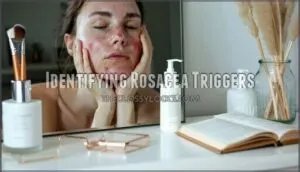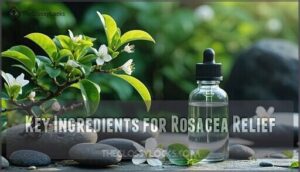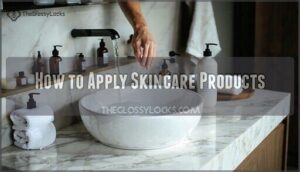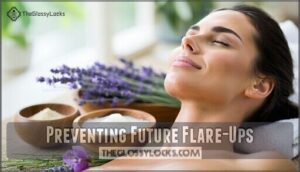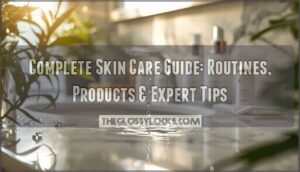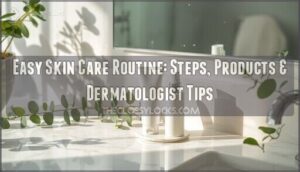This site is supported by our readers. We may earn a commission, at no cost to you, if you purchase through links.

Avoid common triggers like alcohol-based toners, harsh scrubs, and extreme temperatures. Pat products on gently rather than rubbing, and introduce new items one at a time to identify potential irritants.
Consistency matters more than expensive products—your skin craves predictability. The secret lies in understanding which specific ingredients can actually calm inflammation while strengthening your skin’s protective barrier.
Table Of Contents
- Key Takeaways
- Rosacea Skin Care Basics
- Identifying Rosacea Triggers
- Effective Rosacea Skincare Routine
- Managing Rosacea Symptoms
- Maintaining Healthy Rosacea Skin
- Frequently Asked Questions (FAQs)
- What skincare products are good for rosacea?
- What skincare should I avoid if I have rosacea?
- What is the number one trigger for rosacea?
- How often should I moisturize my face if I have rosacea?
- Can rosacea be diagnosed before a major flare-up occurs?
- Is rosacea hereditary and can it run in families?
- How long does rosacea typically last in individuals?
- Can rosacea occur in children and teenagers too?
- Are there support groups available for rosacea sufferers?
- Can makeup be worn with rosacea?
- Conclusion
Key Takeaways
- Start with gentle, fragrance-free basics – You’ll need a mild cleanser, ceramide-rich moisturizer, and broad-spectrum SPF 30+ sunscreen as your daily foundation for managing rosacea symptoms.
- Identify and avoid your personal triggers – You should track what causes your flare-ups (sun exposure affects 81% of patients, stress affects 79%) and create barriers like sun hats and stress management techniques.
- Apply products correctly to prevent irritation – You’ll want to use lukewarm water, pat skin dry instead of rubbing, and wait 5-10 minutes between product applications to avoid stinging.
- Stay consistent for long-term success – You can’t expect quick fixes with rosacea – your skin needs the same gentle routine daily, and tracking your progress helps you adjust when needed.
Rosacea Skin Care Basics
Managing rosacea effectively starts with understanding what your sensitive skin actually needs rather than what conventional skincare tells you to use.
You’ll need to completely rethink your approach, focusing on gentle techniques that protect your skin‘s compromised barrier while avoiding the triggers that send your face into another flare-up, using methods that prioritize your skin’s specific sensitive needs.
Gentle Cleansing Techniques
Gentle cleansing forms the foundation of your rosacea skincare routine. Choose a fragrance-free, nonsoap cleanser that won’t strip your skin’s protective barrier.
Your skin’s barrier needs gentle care, not harsh scrubbing—choose fragrance-free cleansers that protect instead of strip.
- Use lukewarm water and your fingertips—skip washcloths or scrubs
- Cleanse twice daily with gentle, circular motions for 30 seconds
- Pat skin dry with a clean cotton towel, never rub
This gentle cleansing approach prevents irritation while effectively removing impurities, making it a crucial part of your daily skincare routine.
Importance of Moisturizing
Daily moisturizer application rebuilds your skin’s protective barrier and alleviates the dryness that often accompanies rosacea flare-ups.
Hyaluronic acid and ceramide-rich formulas provide superior skin hydration without triggering sensitivity.
These soothing moisturizers deliver barrier repair benefits while maintaining gentle moisturized comfort.
Apply moisturizer 5-10 minutes after cleansing for ideal sensitive care and enhanced moisturizer benefits.
Sun Protection Essentials
Sunscreen becomes your skin’s best friend when you’re battling rosacea.
Choose mineral-based sunscreen with zinc oxide or titanium dioxide—these gentle mineral filters won’t sting like chemical ones.
Look for broad-spectrum protection with SPF 30 or higher to block both UVA and UVB rays.
Don’t forget sun hats and facial shields for extra defense against flare-ups.
When selecting a sunscreen, consider the importance of using products with natural sun protection to minimize skin irritation and environmental impact, and choose mineral-based options for a gentle and effective skin protection.
Identifying Rosacea Triggers
Identifying your rosacea triggers is the key to preventing painful flare-ups before they start.
You’ll need to become a detective of your own skin, tracking what makes your face turn red and inflamed.
Common Triggers to Watch Out For
Since sun exposure triggers flare-ups in 81% of rosacea patients, it’s your skin’s biggest enemy.
Sun exposure isn’t just a trigger—it’s rosacea’s ultimate enemy, affecting 8 out of 10 patients.
Stress management matters too—affecting 79% of sufferers.
Spicy foods and alcohol triggers can turn your face into a tomato, while environmental factors like wind and heat create perfect storms for skin inflammation.
Recognizing these common rosacea triggers helps you dodge facial redness before symptoms strike. Understanding rosacea flare ups is essential for effective management of the condition, which involves being aware of facial redness.
How to Identify Personal Triggers
Keeping a rosacea skin care routine successful means becoming your own detective.
Start trigger tracking by maintaining a detailed food diary alongside your skin mapping observations.
Document everything—what you ate, stress levels, weather conditions, and skincare products used before each flare-up.
This flare analysis helps identify patterns between rosacea triggers and your rosacea symptoms, giving you control over future rosacea flareups.
Tips for Minimizing Exposure to Triggers
Once you’ve pinpointed your personal rosacea triggers, creating barriers becomes your best defense strategy.
Trigger avoidance starts with environmental factors—wear broad-brimmed hats for sun protection and choose gentle, fragrance-free products to prevent skin irritation.
Diet control means limiting spicy foods and alcohol that spark rosacea flareups.
Stress management through deep breathing or meditation helps prevent emotional triggers, and simple lifestyle modifications like using lukewarm water and avoiding harsh scrubbing protect your sensitive skin effectively, which is a key part of stress management and overall skin protection.
Effective Rosacea Skincare Routine
You’ll need a targeted approach to build an effective rosacea skincare routine that calms inflammation without triggering flare-ups.
The key lies in selecting gentle, fragrance-free products with proven ingredients and applying them correctly to support your skin’s compromised barrier.
Choosing The Right Cleanser
Your cleanser choice can make or break your rosacea skincare routine.
Fragrance-free, gentle formulas protect your skin’s natural pH balance while avoiding harsh soap alternatives that strip protective barriers.
- Cleanser Types: Choose cream or lotion-based formulas over foaming varieties that can irritate sensitive skin
- Skin pH: Look for pH-balanced products (5.5-6.5) that won’t disrupt your skin’s natural acid mantle
- Gentle Formulas: Water-based, non-comedogenic options work best for rosacea-prone complexions
When selecting a product, consider using a rosacea cleanser to help manage symptoms effectively.
Key Ingredients for Rosacea Relief
Powerhouse ingredients can transform your rosacea journey from frustrating to manageable.
Azelaic acid leads the charge as an FDA-approved anti-inflammatory that tackles redness and bumps effectively.
Niacinamide strengthens skin barriers while natural remedies like green tea extract provide gentle protection.
Look for soothing agents including ceramides and aloe vera in gentle formulas that won’t trigger flare-ups.
Effective rosacea treatment often involves understanding rosacea skin care principles to find the right balance for your skin.
How to Apply Skincare Products
When applying rosacea skincare products, timing matters like clockwork.
Start with gentle cleansers using lukewarm water and fingertips for gentle massage.
Wait until skin’s completely dry before product layering—this prevents stinging.
Apply treatments first, then moisturizer application five minutes later.
Test new rosacea skincare products on a small skin patch before full use.
Understanding rosacea skin care is essential for managing symptoms and creating an effective routine to help with rosacea skin care.
Managing Rosacea Symptoms
Once you’ve established your gentle skincare foundation, the next step is actively managing rosacea’s most challenging symptoms.
The good news is that with the right approach, you can substantially reduce redness, calm irritated skin, and prevent those frustrating flare-ups that seem to appear at the worst possible moments, which can help in managing the condition effectively.
Reducing Redness and Inflammation
The right ingredients can calm your angry, red skin like a gentle breeze on a sunburned face.
Target inflammation with proven treatments that work at the cellular level to restore balance.
- Niacinamide (Vitamin B3) – Strengthens your skin barrier and reduces redness by 40% in clinical studies
- Azelaic acid – Delivers 70-80% efficacy in reducing facial inflammation and persistent redness
- Green tea extract – Provides antioxidant protection while visibly calming reactive, inflamed skin areas
Understanding rosacea redness causes is essential for developing an effective skincare routine.
Soothing Sensitive Skin
When sensitive skin meets rosacea, your skin barrier becomes your best defense.
Gentle products and calming techniques can transform your sensitive care routine.
| Soothing Strategy | Key Ingredient | Application Method |
|---|---|---|
| Barrier Repair | Ceramides, Hyaluronic Acid | Pat gently with fingertips |
| Anti-Inflammatory | Niacinamide, Aloe Vera | Thin layer, avoid rubbing |
| Hydration Boost | Glycerin, Squalane | Press into skin softly |
| Calming Relief | Colloidal Oatmeal | Light facial massage motions |
Your rosacea skincare needs a gentle skincare approach that respects your skin’s sensitivity while delivering effective relief.
Preventing Future Flare-Ups
Beyond calming your skin, preventing future flare-ups becomes your shield against rosacea’s unpredictable nature.
Consistent trigger avoidance and stress management protect your skin barrier while supporting flare up prevention. Your rosacea skincare routine should focus on gentle skincare and skin barrier repair through rosacea prevention strategies.
- Track your triggers – Keep a diary to identify what sparks your flare-ups
- Build daily habits – Consistent rosacea diet and gentle skincare create lasting protection
- Stay one step ahead – Proactive rosacea flareup prevention beats reactive treatments every time
Maintaining Healthy Rosacea Skin
Successfully managing rosacea requires consistency in your skincare approach rather than quick fixes or occasional treatments.
You’ll need to monitor your skin’s response to products and make gradual adjustments while incorporating lifestyle changes that support your skin’s long-term health.
Importance of Consistency
Consistency forms the backbone of successful rosacea management. Your sensitive skin responds best when you stick to the same daily routine using gentle products.
Think of it like training for a marathon – sporadic efforts won’t get you there, but steady progress will.
Your rosacea skincare routine needs that steady commitment to see real results.
| Consistent Care Benefits | Inconsistent Care Risks |
|---|---|
| Strengthened skin barrier function | Increased inflammation episodes |
| Reduced flare-up frequency | Compromised skin barrier integrity |
| Better product tolerance over time | Heightened sensitivity reactions |
| Improved rosacea symptom control | Unpredictable symptom patterns |
Monitoring and Adjusting Skincare Routine
Throughout your rosacea skincare journey, tracking changes becomes your roadmap to clearer skin.
Monitor how your face responds to different products, weather patterns, and stress levels.
- Keep a daily skin diary noting flare-ups, new products, and triggers
- Photograph your skin weekly to track improvement patterns objectively
- Rotate products gradually when current routine stops working effectively
- Assess your skin type seasonally as rosacea can shift with hormonal changes
Understanding proper rosacea skin care is essential for managing symptoms.
Lifestyle Changes for Rosacea Management
Managing rosacea requires strategic lifestyle changes beyond your skin care routine.
Dietary adjustments help 45% of patients avoid spicy foods and alcohol triggers.
Stress management through meditation reduces flare-ups in 67% of people since stress triggers symptoms in 79% of patients.
Regular sleep patterns support skin barrier function, while controlling environmental factors like temperature extremes prevents flushing.
Social support networks provide emotional resilience during challenging flare-ups. Understanding the importance of healthy skin habits is essential for developing an effective rosacea management plan.
Frequently Asked Questions (FAQs)
What skincare products are good for rosacea?
Imagine your skin as a delicate flower needing gentle care.
You’ll want fragrance-free cleansers like Vanicream, soothing moisturizers with ceramides, mineral sunscreens, and ingredients like niacinamide and azelaic acid to calm inflammation.
What skincare should I avoid if I have rosacea?
Avoid harsh scrubs, alcohol-based toners, fragranced products, retinoids, and chemical sunscreens. Skip glycolic acid, salicylic acid, and astringents—they’re like sandpaper on sensitive rosacea skin, triggering inflammation and worsening redness.
What is the number one trigger for rosacea?
Research shows 90% of rosacea patients identify sunlight as their primary trigger. You’ll find UV exposure consistently worsens symptoms, making daily broad-spectrum SPF 30+ sunscreen your most essential defense against flare-ups.
How often should I moisturize my face if I have rosacea?
You should moisturize your face twice daily if you have rosacea.
Apply moisturizer morning and evening after cleansing to rebuild your skin barrier, reduce dryness, and prevent irritation that triggers flare-ups, this helps to rebuild your skin barrier.
Can rosacea be diagnosed before a major flare-up occurs?
Over 16 million Americans have rosacea, but you can spot early signs before major flare-ups hit. Look for persistent facial redness, frequent flushing, or stinging sensations that don’t resolve quickly.
Is rosacea hereditary and can it run in families?
People with rosacea are four times more likely to have a family history of the disorder, suggesting genetics play a role in its development, though environmental factors also contribute substantially.
How long does rosacea typically last in individuals?
Rosacea doesn’t go away on its own—it’s a chronic condition you’ll manage throughout your life.
While symptoms can calm down between flare-ups, they’ll likely return without proper treatment and trigger avoidance.
Can rosacea occur in children and teenagers too?
While uncommon, children and teenagers can develop rosacea, though it’s typically diagnosed after age thirty.
Early onset cases often present milder symptoms and may be misdiagnosed as acne or eczema initially.
Are there support groups available for rosacea sufferers?
You’ll find genuine support through the National Rosacea Society and online groups like the Rosacea Support Email Group with over 7,500 registered members where you can share experiences and treatment insights.
Can makeup be worn with rosacea?
Yes, you can wear makeup with rosacea, but choose products carefully.
Look for fragrance-free, non-comedogenic formulas designed for sensitive skin.
Green-tinted primers help neutralize redness.
Always remove makeup gently to avoid irritation.
Conclusion
Building an effective skin care routine for rosacea isn’t rocket science—it’s about finding your skin’s sweet spot.
You’ve learned that gentle cleansers, consistent moisturizing, and daily sunscreen form the foundation of success.
Remember to introduce products slowly and listen to your skin’s signals.
With patience and the right approach, you can manage symptoms effectively, and your skin will thank you for treating it with the respect and care it deserves.
- https://www.goldenstatedermatology.com/blog/6-tips-for-managing-and-living-with-rosacea/
- https://pmc.ncbi.nlm.nih.gov/articles/PMC10861432/
- https://mednexus.org/doi/10.1097/JD9.0000000000000304
- https://www.rosacea.org/patients/skin-care-and-cosmetics
- https://www.aad.org/public/diseases/rosacea/triggers/prevent

